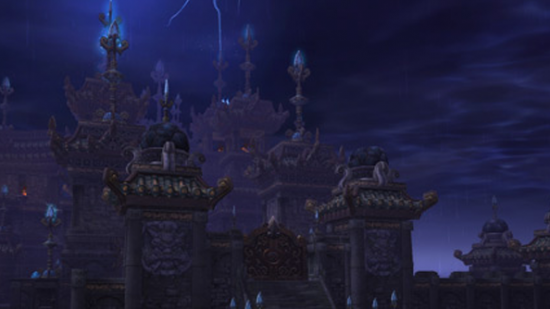Today, World of Warcraft 5.2 launches. It’s got a fancy subtitle and everything: The Thunder King. The centre-piece for the patch is a new raid tier: The Throne of Thunder, where World of Warcraft’s level 90 players can face 12 (13 if you count the heroic hidden one) new bosses. Raids are hard: hard to defeat, and hard to design. Raiding doesn’t feel like anything else in gaming: it requires a level of patience and co-operation that’s rarely found elsewhere. Groups of ten or twenty five players have to come together to defeat some of the hardest challenges in gaming.
I’ve been obsessed with raids in World of Warcraft for a very long time – and I wanted to understand more about how Blizzard design and develop the encounters within. Handily, World of Warcraft’s lead encounter designer, Ion Hazzikostas, was happy to help.
Warning: if you’re wanting to attack the 5.2 Throne of Thunder raid dungeon blind, this interview contains significant spoilers.
Tim Edwards: The thing that struck me is that if you’re designing an encounter you’re kind of acting as a choreographer for the players, is that right?
Ion Hazzikostas: In a sense, yeah. It’s weird. What we’re trying to dictate is gameplay that we think will be good.
For boss number one, in the case of Jin’rokh we wanted something fairly straightforward. I think that one fair criticism of the Stoneguard encounter, at the start of Mogu’shan Vaults (Mists of Pandaria’s first raid zone), might’ve been better placed as the fourth or fifth in the zone.
There was actually a fair bit of complexity and organisation and co-ordination that tanks in particular had to learn in that fight before you could get anywhere. Whereas, if you think back to a zone like Dragon Soul (the final raid tier of the Cataclysm expansion), you just kind of had Morchok at the front, who was probably a bit too easy, but mechanically very simple.
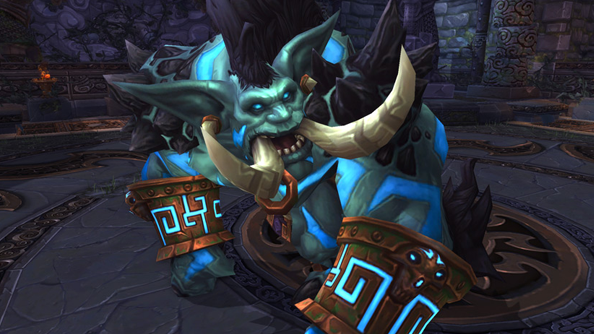
Jin’rokh was designed to be an easier introduction to the raid: he’s a bruiser who will just bash your head in. There’s movement that’s required: you have to take advantage of certain mechanics. He breaks open statues to create pools of water on the ground that buff the raid, but then he can charge them with electricity, which makes them harmful. So you’ll clump together in these helpful pools, but scatter as soon as they become dangerous.
T: Does the first boss in a raid act as a kind of a gear check in a raid… to make sure that the group in question can actually cope with what’s to come?
I: A little bit. I would say that we actually tried to more explicitly gear check maybe three or so bosses in. I think that there are a lot of players who maybe haven’t even finished the first raid tier of Mists of Pandaria, who got stuck on some bosses along the way in the 5.0/5.1 raid tier. I think those players are understandably going to be excited about the release of Throne of Thunder and the new raid zone and potentially new bosses to fight.
We’d like to give those people a fighting chance against the first couple of bosses rather than having them have the experience of turning up at a new raid zone, excited and eager to check it out, and then immediately hit a brick wall that they just can’t overcome. With some good play and co-ordination, they may beat the first couple of bosses, but then they’ll run into a point where they realise, okay, we need some more gear, but they at least have that little toe-hold there.
T: The other thing about the entry bosses is that, if you are a raider, you’re going to be fighting them week after week as you progress. Does that change how you plan the encounter?
I: Yes and no. Certainly we’re aware of that fact. We try to make all of our bosses be interesting, dynamics-wise. If we’re going to do the epic ten to fifteen minute encounter, that’s more likely to be found later in the zone than early on.
One of the main things we added to help with that replayability process has been the introduction of Thunderforged items in the 5.2 patch. Every time a boss drops an item there’s a chance that it’s going to be a more powerful variant of the base item, that’s about six item levels higher.
As you say, when you are working on bosses eight or nine, you’re re-clearing the first seven bosses to get back to the one you’re progressing on, but at that point you may have killed the first couple of bosses eight or nine times and you may have pretty much all the items they’re likely to drop that are useful for your raid. So you kind of go into the fight pretty much expecting that you’re going to disenchant everything that drops. With Thunderforge drops, there’s almost always the chance that this boss will give you an upgrade no matter how many times you kill it.
T: So the next boss is a dinosaur with cannons on his back called Horridon?
I: Yes.
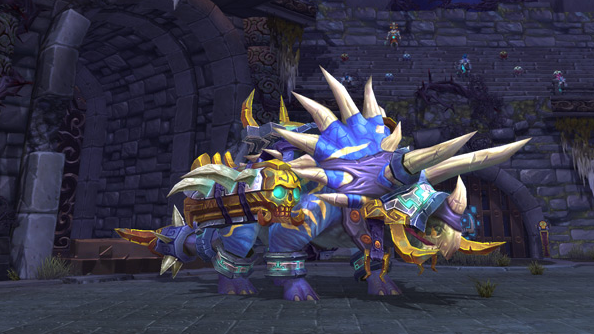
T: The mechanics of this are quite complicated. Can you explain it in the simplest terms possible?
I: This is a multi-stage fight where there are trolls from four tribes. The way the fight plays out is that within the fight a group of trolls will comes from behind gates into the arena. One of those is a powerful Dinomancer which has the ability to control dinosaurs. When you defeat it, it drops an orb that lets you control the dinosaur and force it to destroy the gate.
The gameplay is that you off-tank Horridon while dealing with the trolls coming out of the gates. You use him to destroy the gates, and once you’ve finished off four waves of trolls and the gates are all crushed, now the dinosaur is fully vulnerable and you turn your attention to him.
T: You’ve used off-tanks as a kind of countdown timer in the past. Is that the case here?
I: He does more damage to the off-tank. There’s a tank-swap mechanic where one tank will probably deal with the trolls coming out the gate, the other one with the dinosaur, then they’ll swap periodically.
T: Is the tank swap mechanic become a cliche?
I: I will admit and concede that it’s kind of forced a little, sometimes. It’s kind of a tradeoff between the fiction or the fantasy of the encounter we’re creating and the gameplay realities of the raid group compositions. Most raids, we generally encourage and require you to have two tanks for most fights.
There are some fights where there’s just one big enemy you’re fighting. On some fights where there are lots of adds or, you know, two bosses, it’s very organic and very naturally you’re going to want more than one tank and that works out just fine. But not every encounter’s going to be like that. Sometimes want the ability to say, hey, it’s a dragon. It’s one big dragon, you’re fighting the dragon. But if we just have the one tank tanking the dragon and nothing else, then the second tank literally has nothing to do. It’ll have to either respec to DPS or, in some raid groups, just get swapped out for a player who has the optimal gear to DPS or to heal, and that’s not a great experience for them.
So we try to be mindful, wherever possible, of making sure there’s something for the second tank to do, even if it is kind of the cliché of a stacking) debuffs that you have to tank-swap to prevent it from getting too high.
T: So one of the problems in raid design is in trying to make sure there’s always something for everyone to do.
I: I agree that the very basic situation of the main tank taunts off, you’re sitting there, auto-attacking, doing terrible damage, waiting for your debuff to fade, so that you can taunt back. It’s not the best gameplay when you basically spend 50% of the fight doing something interesting, the other 50% kind of waiting. In a fight like Horridon, when you’re not tanking the dinosaur because of the stacking debuff, you’re dealing with multiple adds. It’s a very different sort of gameplay, you’re switching between tanking one big thing and many small things and I think that’s more dynamic.
In fights like Feng the Accursed, in the Mogu’shan Vaults, it was a similar stacking tank debuff, but there was this whole separate mechanic for the off-tank to use to copy Feng’s abilities, to increase their own damage and potentially also help the raids. We tried to be mindful of adding something else on top of just taunting and waiting for a debuff to fade.
T: So the next point in the raid is the Council of Elders. Council fights, where you fight upto four or more different bosses are always quite hard because there’s so much to manage. Where do you think you’ve got it right, and where do you think you’ve fallen down?
I: We’ve had Council fights for a long time now in the game. I think that, way back in the past, some of them were a bit excessive. Take the Maulgar encounter, in Gruul’s Lair (in the Burning Crusade). The hardest part of the fight by far was just the pull, it was just setting up. Four enemies, you had to get them controlled, and the fight got easier as you went. That’s one of the dangers of the council fight, in terms of the design. If they don’t share health, you just pick one of them off and now there’s just not so much stuff going on, and it’s like it’s easier and easier as you go.
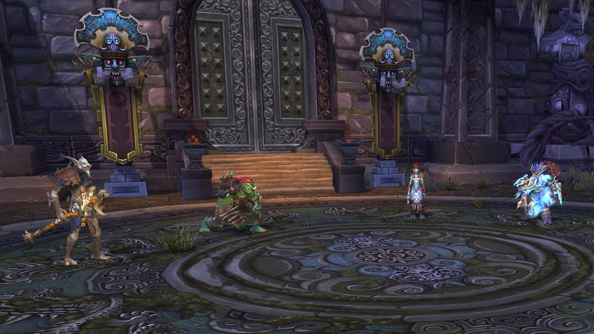
A response to that in the past has just been to make them outright share health. But then the encounter ends up feeling a bit flat, like the Illidari Council, also in Burning Crusade. With pretty much the exact same situation, the exact same setup, just for ten minutes straight you wear down the health of all the Councils evenly. I think in more recent Council fights, what we try and do to change it up a bit is help guide the player’s attention. In the Blood Princes encounter at Icecrown Citadel, only one of the Council members at a single time was attackable and could then be damaged. As that orb shifted around, that dictated the gameplay.
On the Council of Elders fight in Throne of Thunder, we do something similar, where the spirit of Gara’jal the Spiritbinder, who himself had been a Mogu’shan Vaults raid boss, animates and empowers one troll at a time out of the four. When he’s occupying them he gives them an extra ability and whenever he possesses a troll, after forty-five seconds or so, he starts to pulse very heavy raid damage. The only way to force him out of the body is to do a certain percentage of the troll’s health in damage. As Gara’jal skips to a troll, it serves much the same function as that the Blood Orb did in the Blood Princes encounter, where it forces players to shift their attention, but it also gives the fight a feeling of distinct phases.
Each of the Councillors only really has two abilities each, but one of them tends to be a very straightforward ability like a single-target nuke or something, so there really aren’t that many mechanics that you need to manage at the same time, but it still ends up having a dynamic feel as you progress through the encounter.
T: The next boss is Tortos, which is a giant tortoise, who’s grown to become part of a rockface. There’s a slightly odd question that this brings up: in quite a few of raid encouters, it’s only really the tank that will ever get to see the face off the boss, because he’ll want to turn the boss around to face away from the raid…
I: Obviously you have the occasional boss like this who is sessile and facing you and then you don’t have a choice in the matter. I think some of it is just our combat mechanics. Some creatures can parry from the front, they can’t from behind, and we definitely use frontal cone attacks and so people want to generally point those away from the raid. I think that leads to that gameplay, a little bit.
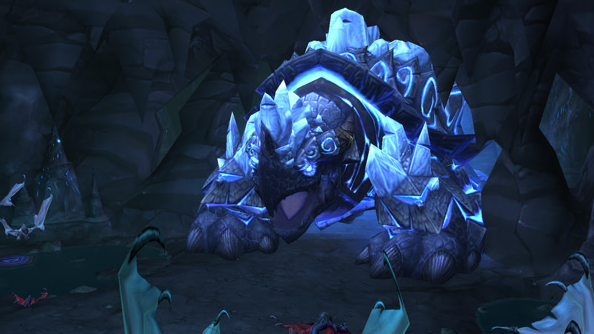
On a technical side, I think we try to have, whether it’s transition phases or special abilities the boss has, something that makes it animate in a different way, or it stops and channels, or does something to the raid as a whole that lets you get a sense of its front and what it looks like from all sides, instead of you just stabbing its ankle for five minutes straight, which isn’t ideal.
I think the Tortos fight in particular, that was more of just an outgrowth of a cool visual concept that we had in our heads when we were brainstorming it, the idea that you’ve fallen down into this ancient subterranean area that’s pretty much forgotten and there’s just this giant turtle that’s so large that it’s actually physically grown into the rock wall and it’s blocking your path. It’s not necessarily an evil creature, it’s just primal, it’s attacking in self-defense, but you need to through it because you’re trapped.
T: Let’s talk healing: how do you make playing whack-a-mole with health bars feel fun? .
I: We’re definitely mindful of trying to create interesting healer gameplay, which often really just entails variation on their part. I think that, particularly in twenty-five player raids, any raid mode where you have twenty-five people, there’s a tendency just to use your AOE heals because they’re hitting the most people. The least interesting type of damage, as a healer, is just flat-rate damage, where there’s just pulsing damage that hits the whole raid and you maybe stack up and the priest spams Prayer of Healing, the shaman spams Chain Heal, etc. I think that more interesting healing dynamics are responding to single-target damage spikes, changing damage profiles, where you have very heavy damage on a tank that then subsides and turns into, say, more raid-wide, evenly distributed damage, such that you’re switching between modes of heavy single-target healing and raid-wide healing.
Movement and position also affect this a lot. Players will tend to clump up whenever possible because there’s so many heals that are very efficient when the whole raid is stacked in one spot. So if we prevent you from doing that with use of mechanics, well, now you can’t use your Chain Heal effectively, you have to single-target heal to keep people up and you’re making much more active decisions. It’s more of a triage process where you’re looking at who has the lowest health, who is currently taking the most damage, who needs a heal first. I think that’s a lot of what’s engaging about healer gameplay.
T: Can we look at the Lei Shen fight and talk a little bit about its evolution? You said on the Warcraft blog that it started out with the mechanic of a battery, but I don’t quite understand how it went from this idea that some of it charges into the boss that you have now.
I: The original idea was that we knew we wanted some kind of intermission phase, like we had on the Ragnaros encounter, where between key phases of the fight he is powering up, or something along those lines. One thought was that was, okay, he is this powerful Mogu, crackling with electricity, but after a certain period he becomes worn down and needs to go and recharge, like the curator fight back in Karazhan. That was the original concept, but we thought it would be more interesting, and someone had the very clever idea, of well, actually, what if he is just inherently a source of power? What if it’s not that he is running out of power, but actually the intermission is him channeling even more power into this structure? The dungeon art and the design of the entire wing of that dungeon actually evolved to reflect this concept. It was almost a kind of a living battle citadel that could be charged up by the Thunder King’s own energy to attack and to have defences that came to life and tried to harm the player.
The way the actual fight plays out, the platform that you fight him on has four quadrants, each of which has a pillar that activates a very specific, powerful defence. Lei Shen himself, if you keep him in the middle of the room or you move him around, he’s actually arcing electricity, arcing lighting, doing very heavy damage to the raid. If you move him to one of the corners of a platform, near one of the pillars, it kind of tethers him and his energy charges that pillar, activating that ability, but also empowering it more and more over the course of the fight, so the longer you spend in one quadrant, the more powerful that ability is going to be. You need to move him from section to section of the room and you choose the order in which you do this. You’re choosing which abilities he’s going to use when and how much they’re going to be powered by.
The intermission phase has him actually go to the center of the platform and this sort of custom device comes out of the ground that lets him charge up all four corners of the room simultaneously and so his own abilities are taken out of the fight during the intermission. Normally during the pacing of the fight, during the main phases, he has his own weapon-based attacks, plus the one ability from the one quadrant you’re in. When he goes to the middle of the room in the intermissions, he stops attacking, but you have to deal with all four quadrant abilities simultaneously. That’s the overall sort of ebb-and-flow pacing of the fight.
T: So it’s hard.
[everyone laughs]
T: Okay: what do you think the hardest fight, the greatest technical challenge for raiders has been in WoW so far?
I: The hardest fight that I think we have made, in the history of the game, that was actually beatable and not bugged if you go all the way back to vanilla days, was the heroic Ragnaros encounter in Firelands.
T: Is it healthy for the game, to have something that hard to aim for?
I: I think it is, yes. I think that at the high end of our heroic content it’s important to have encounters that are difficult and challenging enough to let the best players differentiate themselves from each other. If we make a fight that is moderately hard, but not extremely so, and there are twenty guilds in the world that can go in and beat it in one night, and it’s very, very hard for everyone else, and it’s a good challenge for everyone else, it hasn’t really answered the question of who, out of those top twenty guilds, who is the best.
It’s nice to push the difficulty envelope to a certain extreme, to let those players sort themselves out. And you can see the difference. It took one group six days to beat it, it took another group nine days, it took another group twelve days. They all eventually beat it, but there are some gradations there. Now, the problem with heroic Ragnaros was that Firelands only had seven bosses, and so having that sort of difficulty jump left us with a situation where the first six bosses were something that, you know, probably a thousand guilds in the world could defeat. But then, the seventh boss, Ragnaros, was something that only twenty guilds in the world could defeat and that leaves nine hundred and eighty guilds feeling left out.
That’s a big part of why we tried to move towards somewhat larger raid tiers. We have thirteen bosses in Throne of Thunder. So, when you have thirteen bosses I think it’s okay for the last couple to be really brutally hard. Everyone is going to find something along the way that really suits their level of skill and time investment.
Thanks to Ion for taking the time to chat. World of Warcraft 5.2 is out now.
